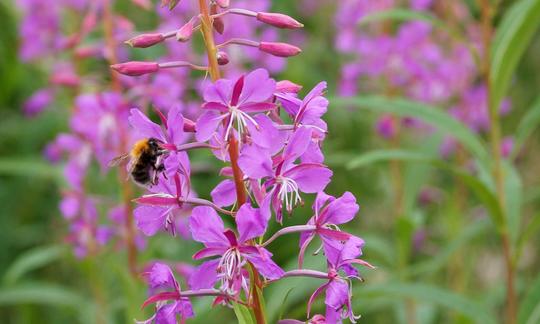Table of contents
Is narrow-leaved willowherb edible? Apart from the leaves, all parts of the plant ( organic ?) of the so-called fireweed ( Epilobium angustifolium) can be eaten raw.
Use in the kitchen
Raw and unprocessed plant parts leave a slightly dull to rough coating on the palate. This effect can be alleviated by soaking the finely chopped plant parts in citric or acetic acid. Young, above-ground plant parts taste like lamb's lettuce and the roots are sweet and spicy.
How can you eat and prepare fireweed? The sprouts (April-May) have an asparagus-like aroma. Shoot tips and young, tender leaves before flowering (April-July) are used in a similar way to spinach. Young, elastic stems taste good peeled raw and cooked as stem vegetables. Flowers and buds (July-Aug.) are suitable as a decorative soup ingredient or as an addition to salads and raw foods. Cleaned or peeled roots can be eaten raw or added to vegan patties, soups and root vegetables. The roots of the species Epilobium angustifolium in particular are a traditional vegetable in eastern Poland.
Vegan recipe for stir-fried vegetables with fireweed
Ingredients (for 2 people): 1 tomato (organic), diced; 1 small zucchini (organic), diced; 1 carrot (organic), grated; 20 g young fireweed leaves and buds; 40 g organic macadamia nuts, chopped; 5 g fresh ground ivy, finely chopped; 5 g raw fireweed flowers.
Preparation: Sauté the chopped tomato, zucchini and carrot in a non-stick pan for 5 minutes without adding any fat. Add the leaves (willowherb leaves) and cook for a further 5 minutes. Mix the vegetables with the nuts and raw ground ivy, arrange on two plates and decorate with the flowers.
Recipe for making willowherb tea
During the season from May to July, a type of green tea can be prepared from raw leaves and flower buds. To do this, you can boil the fresh plant parts of the willowherb. You get a tasty drink together with some fennel seeds. 1
If you want to make fireweed tea yourself, you need 1.5-2 g (1 tsp = 0.8 g) of chopped herb. Pour 150 ml of boiling water over this and strain the tea (in English Fireweed Tea or Chamaenerion Tea) after 5-10 minutes. 2,3 For medicinal purposes, drink a cup 2-5 times a day. 2
What is fermented fireweed tea? In Russia, this tea preparation is known as Ivan tea, Ivan chai, Kurilian tea or Russian tea, formerly known as Koporskij chai (Копорский чай). The caffeine-free and aromatic alternative to black tea has a tart, sweet taste.
Vegan recipes with willowherb can be found under the note: " Recipes that have the most of this ingredient ".
| Not only vegans or vegetarians should read this: Vegans often eat unhealthily. Avoidable nutritional deficiencies |
Purchasing - Storage
You can buy willowherb tea from some manufacturers. The herb available in stores is a mixture of various Epilobium species and consists of broken leaves and stem pieces and a few pieces of fruit and flowers. 3 Willowherb tea is available in organic quality, as a conventional product or from wild collection in online shops, health food stores, pharmacies and organic shops. The chew is often a component of home and herbal teas (e.g. Aurica ® small-flowered willowherb tea, Bombastus small-flowered willowherb herb, Salus ® willowherb mixture).
We have not yet found any products containing the medicinal herb in supermarket chains such as Coop, Migros, Denner, Volg, Spar, Aldi, Lidl, Rewe, Edeka, Hofer or Billa, nor in the organic supermarkets Denn's Biomarkt or Alnatura.
Is there a medicinal product for narrow-leaved willowherb? Fluxonorm ® is a dietary supplement that contains water-soluble extracts of common goldenrod ( Solidago virgaurea), Phyllanthus niruri, Epilobium angustifolium (fireweed), boldo ( Peumus boldus) and spiny restharrow ( Ononis spinosa). Occasionally, other herbal medicines contain willowherb.
The availability of narrow-leaved willowherb varies depending on the size of the store, catchment area, etc. Our recorded food prices for the DA-CH countries can be found above under the ingredient image - and by clicking you can see their development at various suppliers.
in the wild
Found The plant (fireweed) is spread all over the world and is found all over Europe. It usually occurs in groups and is usually very common. As a pioneer plant in bare soil, it can be found in the wild in the following places: forest edges, clear-cuts (fireweed), embankments, fallow land, bushes, railway ballast, rubble sites (rubble flower), rocky debris and fresh, nutrient-rich soils. 4
Storage tips
To preserve wild willowherb, you can dry it. To do this, spread the stems out in a well-ventilated place without direct sunlight when they are about to bloom or are in bloom, or tie them into bouquets and hang them up with the flowers facing downwards.
Another option is to ferment willowherb. Wilted leaves are rolled up and cut into fine strips. The leaf structure is then broken up by kneading or using a rolling pin so that juice can escape. The leaves are spread out on a clean cloth and sprayed very lightly with a little water. Then they are rolled up in the cloth and the whole thing is placed in an airtight jar. The fermentation period is three days at room temperature. The leaves are then dried gently for storage, e.g. in the oven at 40 °C (raw food quality). Successful fermentation can be recognized by the floral, sweet scent of the dried leaves.
Ingredients - Nutritional values - Calories
100 g of raw willowherb leaves have a calorie content of 44 kcal. Fats are 0.8 g/100g, carbohydrates 6.3 g/100g and proteins 3 g/100g. 5.6
They are particularly rich in vitamin C, with 99 mg/100g. More ascorbic acid can be found in raw garlic mustard (261 mg/100g), fresh wild garlic (150 mg/100g), raw ground elder (140 mg/100g) or sorrel (117 mg/100g). 5,6
Other secondary ingredients are ellagitannins (oenothein A and B), 1-2% flavonoids (especially quercitrin (dominant), myricitrin, isomyricitrin), 3.7 tannins and sterols. 2
Investigations showed that above-ground plant parts (except stems) collected in July-August have stable and high phenol values. 8
Willowherb products usually consist of mixtures of different species with different, barely identified phenol contents. The combination and ratio of the flavonoids is therefore often unclear. 7 There is no pharmacopoeia quality description for Epilobii herba. 2
The complete ingredients of willowherb, the coverage of the daily requirement and comparison values with other ingredients can be found in our nutrient tables. In the article Nutrients explained you will get a detailed insight into the topic.
Effects on health
Does narrow-leaved willowherb have effects on health? Clinical studies with Epilobium angustifolium on humans are almost non-existent, in contrast to numerous laboratory studies. 10 The HMPC noted the lack of clinical studies. 9 Only one randomized, double-blind and placebo-controlled study has been published in the medical database PubMed. The scientists found that taking standardized capsules with Epilobium angustifolium for six months significantly improved symptoms in 128 patients with benign prostatic hyperplasia. No subjects reported side effects and the dietary supplement showed no liver or kidney toxicity. 10
The dietary supplement Fluxonorm ® contains, among other things, aqueous extracts of Epilobium angustifolium. A study of patients who received one tablet of Fluxonorm ® (1200 mg) for 30 days shows an improved effectiveness of the standard therapy for the treatment of lower urinary tract symptoms. 11
A scientific review concludes that the wild plant is used to treat skin diseases. Oenothein B protects against oxidative damage, influences wound healing and relieves inflammation. The extracts did not show any great toxicity to skin cells. However, there are too few in vivo tests in the literature on applications to the skin. 12
In vitro studies with extracts from Epilobium angustifolium show a statistically significant inhibition of cell proliferation of prostate cancer cells. The tannin oenothein B proved to be the strongest inhibitor. The results of the work provide an explanation for the activity of the extracts and support the use of Epilobium preparations in the treatment of prostate diseases. 13,14,15
Laboratory analyses showed that plant extracts (fireweed) have a high radical scavenging activity, comparable to that of the known antioxidants Trolox and ascorbic acid. 7
Animal studies have shown potentially therapeutic properties of standardized extract in relation to estrogen-related diseases. More complex studies are needed to evaluate safety and efficacy. 16
Dangers - Intolerances - Side effects
Does wood willowherb tea have side effects? There are no known side effects or interactions from using the herb. 2 At the time of the evaluation by the HMPC ( Committee on Herbal Medicinal Products) in 2016, there were no reports of side effects from medicines containing Epilobium angustifolium. The herb can be taken long-term. It has no relevant use in patients under 18 years of age. 9
Use as a recognized medicinal plant
The HMPC classified the plant at European level as a traditional herbal medicinal product (trad. use) according to AMG § 39a. ESCOP ( European Scientific Cooperative on Phytotherapy) and Commission E ( Expert Commission for Herbal Medicinal Products) have not yet produced a plant monograph. 2
In the case of complaints of the urinary tract, the herb (fireweed) can be used based on many years of experience and the fulfillment of the standardized requirements of the HMPC for benign prostatic hyperplasia (BPH). A serious illness should be ruled out by a doctor and regular check-ups should be carried out. It should be noted that Epilobium angustifolium is used for symptomatic treatment and to improve the complaints, but does not prevent the prostate from enlarging. 2
Folk medicine - natural medicine
In contrast to other medicinal plants, the herb (fireweed) has no historical tradition. It received little attention and was dismissed as a weed. From the middle of the last century, there were increasing written references to it and in recent times the wild plant has attracted attention due to its active ingredients. 1
The medicinal plant is used in empirical medicine for urination disorders associated with benign prostatic hyperplasia (BPH). Experience reports and empirical evidence show successful use. 3
Ecological footprint - animal welfare
Despite extensive research, we have not found any essential information/data/figures on the ecological footprint of narrow-leaved willowherb.
In general, it should be remembered that the CO2 footprint and water footprint of a food depend on various factors. The type of agricultural production (conventional vs. organic), average or seasonal or regional production, domestic production or import by truck, ship or plane, different types of packaging and whether the goods are fresh or frozen all play a decisive role.
Detailed explanations of various sustainability indicators (such as ecological footprint, CO2 footprint, water footprint) can be found here.
Animal welfare - species protection
(Wood) willowherb is an important food plant for bees, mainly in the months of June and July (summer forage). In addition to bees, bumblebees, wasps and various butterflies are common pollinators. 4 Roe deer also have a preference for willowherb. The caterpillars of some species of hawk moths ( Sphingidae) feed mainly or even exclusively on willowherb. 19
Only cut off drying parts of the shrubs in spring. Insects like to hide in them during the cold season and provide a welcome source of food for local birds in winter.
Caution: Some species of the willowherb family ( Epilobium sp.) can become invasive in non-native areas. 20
Worldwide occurrence - cultivation
Epilobium angustifolium grows throughout the northern hemisphere and is found in Europe in a scattered to widespread manner. The wild plant is often found in nature disturbed by humans ("anthropogenic"). 1,3,17
Growing in the garden or as a potted plant
The characteristic, pink-flowering tall perennial can be grown in the garden as a decorative bee pasture. In addition to the seeds for the classic pink to purple wild plant, seeds for white-flowered variants can be found in (online) shops. Four to six plants are planted per square meter, with a distance of 40 to 50 cm. They thrive particularly well in sunny or partially shaded open spaces and prefer dry to fresh, low-lime and averagely permeable soil.
Narrow-leaved willowherb in the garden - what should you bear in mind? Willowherb multiplies quickly through runners and self-seeding. To avoid the latter, you can cut the willowherb back before the seeds ripen. This will also encourage the willowherb to bloom again. As it has deep roots, cultivation as a pot plant is less suitable.
Possible confusion
All species (of fireweed) are edible and there is no direct danger of confusion with poisonous counterparts. In the young growth stage, flowerless shoots can be confused with common goldenrod ( Solidago virgaurea). Goldenrod is edible and a traditional herbal medicine according to HMPC.
The undersides of goldenrod leaves have a clear, slightly darker nerve network. The leaf edges of Epilobium angustifolium (fireweed) are bent downwards and the underside of the leaf is blue-green and has clearly visible leaf veins. Lateral veins run at right angles to the central vein. 18
Further information
The narrow-leaved willowherb ( Epilobium angustifolium) is one of 190 species worldwide and 30 in Europe within the genus Epilobium and belongs to the evening primrose family (Onagraceae). The species form numerous hybrids among themselves, which can make it difficult to distinguish them.
Similar looking species include the hairy willowherb ( Epilobium hirsutum) or the small-flowered willowherb ( Epilobium parviflorum). The glandular willowherb ( Epilobium ciliatum) is a North American species that has spread quickly in Europe. Also known in Europe is the mountain willowherb ( Epilobium montanum).
Epilobium is composed of the three Greek words epi (on), lobos (pod) and ion (violet). The specific epithet angustifolium refers to the shape of the leaves (Latin angustus for narrow and folium for leaf). 2
Alternative names
German-language common names are perennial fireweed (perennial fireweed), fireweed, wood willowherb (wood willowherb), woodland willowherb (woodland willowherb), willow-rose, willow-roeschen, rubble flower, St. Antonie's herb, boar's herb, cancer flower, Kuril tea (flower), monster's herb and wild Wilge.
Alternative botanical names for willowherb (Latin) are: Chamaenerion angustifolium (L.) Scop. ssp. circumvagum (Mosq.) Moldenke; Chamerion platyphyllum (Daniels) A. & D. Löve; Epilobium angustifolium L. var. abbreviatum (Lunell) Munz; Epilobium angustifolium L. ssp. circumvagum Mosq.; Epilobium angustifolium L. var. macrophyllum (Hausskn.) Fern.; Epilobium angustifolium L. var. platyphyllum (Daniels) Fern 17 or Chamerion angustifolium.
Incorrect spellings include Weideröschen, Schmalblättriges Weideröschen or Weidenröscheb.
In English it is called fireweed (not wireweed, Polygonum aviculare), willowherb, blooming sally or rosebay willowherb.
Other uses
In the past, the seed hairs of the wild plant were used to make candle wicks, to stuff pillows and, when mixed with goat's wool, to weave fabrics. Stem fibers were processed into cords and fishing nets.
Bibliography - 20 Sources
| 1. | Niederegger O, Mayr C. Heilpflanzen der Alpen. Gesundheit aus der Natur von A bis Z. Innsbruck: Tyrolia-Verlag; 2006. |
| 2. | Arzneipflanzenlexikon.info Weidenröschen. |
| 3. | Blaschek W. (Hrsg.). Wichtl –Teedrogen und Phytopharmaka. Ein Handbuch für die Praxis. Stuttgart: Wissenschaftliche Verlagsgesellschaft mbH; 6. Auflage. 2016. |
| 4. | Kremer BP. Mein Garten – Ein Bienenparadies. Bern: Haupt Verlag; 2. Auflage. 2018. |
| 5. | Diet-Health.info Nährstofftabellen. |
| 6. | USDA. (United States Department of Agriculture). Nährstofftabellen. |
| 7. | Hevesi Tóth B, Blazics B, Kéry Á. Polyphenol composition and antioxidant capacity of Epilobium species. Journal of Pharmaceutical and Biomedical Analysis. 2009;49(1):26-31. |
| 8. | Jürgenson S, Matto V, Raal A. Vegetational variation of phenolic compounds in Epilobium angustifolium. Natural Product Research. 2012;26(20):1951-1953. |
| 9. | Ema.europa.eu Epilobii herba. |
| 10. | Esposito C, Santarcangelo C, Masselli R, et al. Epilobium angustifolium L. extract with high content in oenothein B on benign prostatic hyperplasia: A monocentric, randomized, double-blind, placebo-controlled clinical trial. Biomedicine & Pharmacotherapy. 2021;138:111414. |
| 11. | Orlando G, Chiavaroli A, Ferrante C, et al. Protective effects induced by the food supplement Fluxonorm® in the lower urinary tract. European Review for Medical and Pharmacological Sciences. 2021;25(7):3074-3082. |
| 12. | Nowak A, Zielonka-Brzezicka J, Perużyńska M, Klimowicz A. Epilobium angustifolium l. As a potential herbal component of topical products for skin care and treatment - a review. Molecules. 2022;27(11):3536. |
| 13. | Deng L, Zong W, Tao X, et al. Evaluation of the therapeutic effect against benign prostatic hyperplasia and the active constituents from Epilobium angustifolium L. Journal of Ethnopharmacology. 2019;232:1-10. |
| 14. | Stolarczyk M, Piwowarski JP, Granica S, Stefańska J, Naruszewicz M, Kiss AK. Extracts from epilobium sp. Herbs, their components and gut microbiota metabolites of epilobium ellagitannins, urolithins, inhibit hormone-dependent prostate cancer cells-(Lncap) proliferation and psa secretion: effect of epilobium on prostate cells proliferation and psa secretion. Phytother Res. 2013;27(12):1842-1848. |
| 15. | Kiss A, Kowalski J, Melzig MF. Induction of neutral endopeptidase activity in PC-3 cells by an aqueous extract of Epilobium angustifolium L. and oenothein B. Phytomedicine. 2006;13(4):284-289. |
| 16. | Kujawski R, Mrozikiewicz PM, Bogacz A, et al. [Influence of standardized extract of Epilobium angustifolium on estrogen receptor alpha and beta expression in in vivo model]. Ginekol Pol. 2010;81(8):600-605. |
| 17. | Gobotany.newenglandwild.org Chamerion angustifolium. |
| 18. | Stadt Bern (Hrsg.). Merkblatt Goldrute. Stadtgrün Bern. Fachstelle Natur und Ökologie. Bern. PDF. |
| 19. | Schmidt O. Schwärmer schwärmen für Weidenröschen: Die Raupen mancher Schwärmerarten haben Weidenröschen zum Fressen gern. ÖWF aktuell 101/2014. |
| 20. | Ronzhina DA. Ecological Differentiation between Invasive and Native Species of the Genus Epilobium in Riparian Ecosystems Is Associated with Plant Functional Traits. Russ J Biol Invasions. April 2020;11(2):132–42. |








Comments